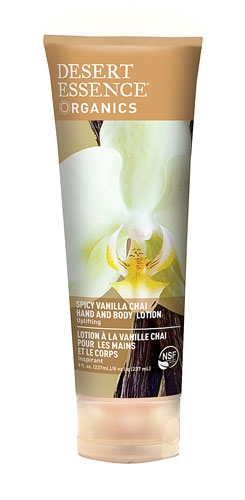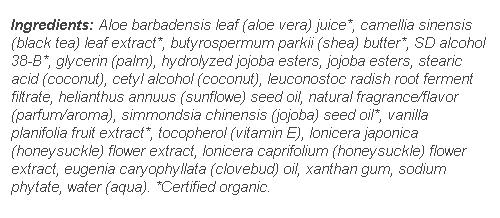| Aloe Barbadensis Leaf | Aloe Barbadensis leaf juice can soothe skin and serve as an anti-inflammatory. It can be efficiently used topically, because of its burn healing effects, scar reducing and wounds healing properties. |
|---|
| Camellia Sinensis | Camellia sinensis contains caffeine and it has been used to increase alertness. Green tea has also been used for cancer prevention, to lowercholesterol, and to prevent/delay Parkinson’s disease. |
|---|
| Butyrospermum Parkii | As an emollient and moisturizer, shea butter helps repair the skin and is an effective remedy for dark spots, wrinkles, stretch marks and sunburn. Its healing properties help treat minor burns, small wounds and insect bites. |
|---|
| SD Alcohol 38-B | Often an SDA is used in cosmetic products but can also be used in chemical manufacturing, pharmaceuticals, and solvents. The use of denatured, non-beverage suitable, alcohol in the USA avoids excise taxes on alcohol. |
|---|
| Glycerin | Glycerin is what is called a humectant. Glycerin helps maintain the skin’s water balance on an intercellular level. Glycerin in lotions or other skin care products can help prevent or combat dry skin. |
|---|
| Hydrolyzed Jojoba Esters | There is an interest in using jojoba for balding because some people think that unclogged hair follicles are more likely to produce new hair. |
|---|
| Jojoba Esters | There is an interest in using jojoba for balding because some people think that unclogged hair follicles are more likely to produce new hair. |
|---|
| Stearic Acid | Stearic acid is one of many fatty acids that occur naturally in various plants and animal derivatives. It’s found in such products as animal tallow, cocoa butter and vegetable fats. When it’s used in cosmetic products, stearic acid primarily fulfills the role of a thickener or hardener. Stearic acid is the substance that helps your bar of soap retain its shape — just as it does in products such as candles, oil pastels and hard candies. |
|---|
| Cetyl Alcohol | Cetyl alcohol is used in the cosmetic industry as an opacifier in shampoos, or as an emollient, emulsifier or thickening agent in the manufacture of skin creams and lotions. It is also employed as a lubricant for nuts and bolts, and is the active ingredient in some “liquid pool covers” (forming a surface layer to reduce evaporation and retain heat). |
|---|
| Leuconostoc Radish Root Ferment Filtrate | Radish root ferment filtrate crops up in a couple of mainstream beauty products such as Peter Thomas Roth Lashes to Die For and Elizabeth Arden Prevage Body. Although Elizabeth Arden completely defeats the object by hedging its bets by adding most parabens known to man and several other preservatives including phenoxyethanol. |
|---|
| Helianthus Annuus | The seeds have diuretic and expectorant properties and have been employed with success in the treatment of bronchial, laryngeal and pulmonary affections, coughs and colds, also in whooping cough. |
|---|
| Natural Fragrance/Flavor | Perfumes |
|---|
| Simmondsia Chinensis | In manufacturing, jojoba is used as an ingredient in shampoo; lipstick; makeup; cleansing products; and in face, hand, and body lotions. |
|---|
| Vanilla Planifolia Fruit Extract | Natural vanilla extract contains numerous antioxidants, including vanillic acid and vanillin. |
|---|
| Tocopherol | Vitamin E is an essential vitamin for the human body. Out of the eight tocopherols, alpha-tocopherols are the most commonly available and are also preferentially absorbed and used by the body. |
|---|
| Lonicera Japonica | Maintain Blood Sugar Level |
|---|
| Lonicera Caprifolium | Swelling (inflammation) of small air passages in the lung (bronchiolitis) |
|---|
| Eugenia Caryophyllata | Clove is used for upset stomach and as an expectorant. Expectorants make it easier to cough up phlegm. |
|---|
| Xanthan Gum | Xanthan gum is frequently added to semiliquid cosmetics and lotions. Adding xanthan gum to cosmetic agents allows for a smoother, more even application. Xantham gum can also be found in medications and pills, and has been used alone as a synthetic saliva for people who suffer from dry mouth. |
|---|
| Sodium Phytate | Phytase is an enzyme that has the ability to liberate the phosphate and mineral residues from phytic acid (phytate), a compound formed during the maturation process of plant seeds and grains that is commonly found in plant-based foods. |
|---|




Reviews
There are no reviews yet.